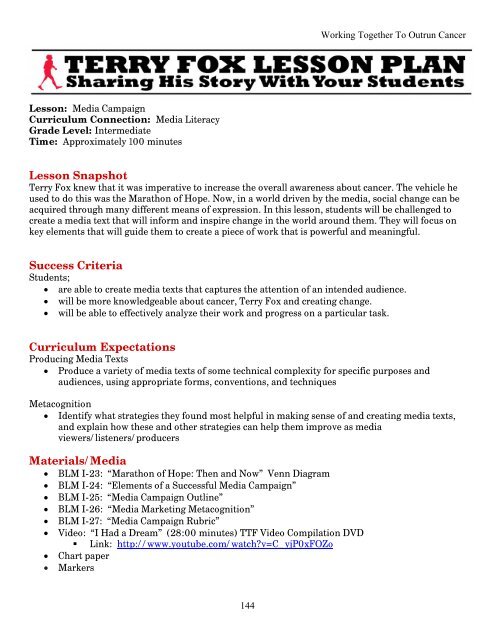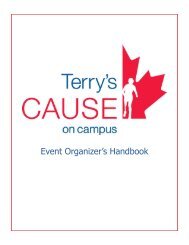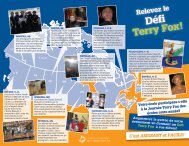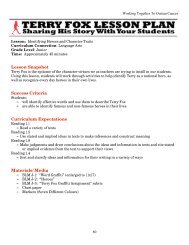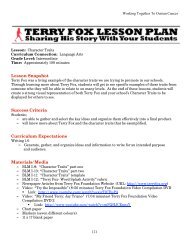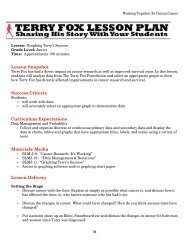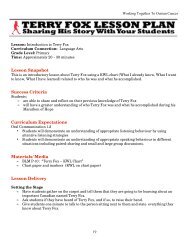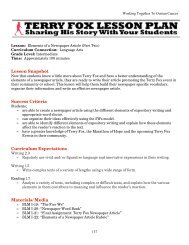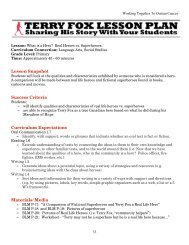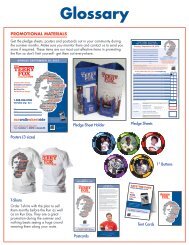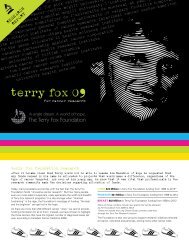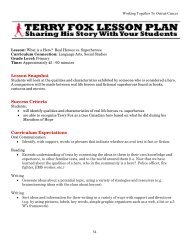Media Campaign - Terry Fox Foundation
Media Campaign - Terry Fox Foundation
Media Campaign - Terry Fox Foundation
You also want an ePaper? Increase the reach of your titles
YUMPU automatically turns print PDFs into web optimized ePapers that Google loves.
Working Together To Outrun Cancer<br />
Lesson: <strong>Media</strong> <strong>Campaign</strong><br />
Curriculum Connection: <strong>Media</strong> Literacy<br />
Grade Level: Intermediate<br />
Time: Approximately 100 minutes<br />
Lesson Snapshot<br />
<strong>Terry</strong> <strong>Fox</strong> knew that it was imperative to increase the overall awareness about cancer. The vehicle he<br />
used to do this was the Marathon of Hope. Now, in a world driven by the media, social change can be<br />
acquired through many different means of expression. In this lesson, students will be challenged to<br />
create a media text that will inform and inspire change in the world around them. They will focus on<br />
key elements that will guide them to create a piece of work that is powerful and meaningful.<br />
Success Criteria<br />
Students;<br />
are able to create media texts that captures the attention of an intended audience.<br />
will be more knowledgeable about cancer, <strong>Terry</strong> <strong>Fox</strong> and creating change.<br />
will be able to effectively analyze their work and progress on a particular task.<br />
Curriculum Expectations<br />
Producing <strong>Media</strong> Texts<br />
Produce a variety of media texts of some technical complexity for specific purposes and<br />
audiences, using appropriate forms, conventions, and techniques<br />
Metacognition<br />
Identify what strategies they found most helpful in making sense of and creating media texts,<br />
and explain how these and other strategies can help them improve as media<br />
viewers/listeners/producers<br />
Materials/<strong>Media</strong><br />
BLM I-23: “Marathon of Hope: Then and Now” Venn Diagram<br />
BLM I-24: “Elements of a Successful <strong>Media</strong> <strong>Campaign</strong>”<br />
BLM I-25: “<strong>Media</strong> <strong>Campaign</strong> Outline”<br />
BLM I-26: “<strong>Media</strong> Marketing Metacognition”<br />
BLM I-27: “<strong>Media</strong> <strong>Campaign</strong> Rubric”<br />
Video: “I Had a Dream” (28:00 minutes) TTF Video Compilation DVD<br />
• Link: http://www.youtube.com/watch?v=C_yjP0xFOZo<br />
Chart paper<br />
Markers<br />
144
Working Together To Outrun Cancer<br />
Lesson Delivery<br />
Setting the Stage:<br />
Show “I Had a Dream Video”.<br />
During the video, have students jot down how things have changed since 1980 (ie. cars, TVs,<br />
radio, clothes, etc) and what has stayed somewhat the same using the Venn Diagram provided<br />
(BLM I-23).<br />
After the video, discuss the changes they recorded on their sheet.<br />
Ask students, “How would raising money during the Marathon of Hope be easier<br />
now, than it was back then?”<br />
Lead students into a discussion about how media has evolved due to the Internet and other<br />
improvements in technology.<br />
Core Learning Activity<br />
As a class, brainstorm on an anchor chart the ways in which we would promote the run now.<br />
For instance; TV, Radio, internet, podcasts, social media, blogs, posters, magazines,<br />
newspaper, email, texting, apps, Skype, public service announcements (PSA), commercials,<br />
YouTube videos, etc.<br />
Ask them, “What career is usually responsible for promoting events, products,<br />
etc?”<br />
Discuss how advertising and marketing play a major role in what we choose to buy, like,<br />
support, endorse, etc.<br />
Discuss with students different elements that are important to consider when creating an<br />
advertisement campaign. Lead students to the following ideas: Target audience, Unique<br />
Concept, Strong Content, Creative Design, Appropriate Voice.<br />
Break students into smaller groups and give each group one of these elements. Have them<br />
discuss why these elements are important and give examples from current media campaigns<br />
that support their answers.<br />
Have each group present their ideas and discuss their findings.<br />
As a class, record their ideas under each element on the ‘Elements of a Successful <strong>Media</strong><br />
<strong>Campaign</strong>’ sheet (BLM I-24). Use these ideas as your expectations for their final assignment.<br />
Application of Information<br />
Hand out the ‘<strong>Media</strong> <strong>Campaign</strong> Outline’ sheet (BLM I-25) and discuss expectation for this<br />
assignment using the ‘<strong>Media</strong> <strong>Campaign</strong> Rubric’ (BLM I-27).<br />
Students are to create an advertising campaign for The <strong>Terry</strong> <strong>Fox</strong> <strong>Foundation</strong> that either<br />
promotes their community/school event, <strong>Terry</strong>’s story or increases peoples’ awareness about<br />
cancer.<br />
They may select one or several of the types of advertising discussed earlier in class. A list of<br />
some of the types of advertising are on the ‘<strong>Media</strong> <strong>Campaign</strong> Outline’ (BLM I-25).<br />
Have students work independently, in pairs or small groups depending on your class.<br />
Students must hand in ‘<strong>Media</strong> <strong>Campaign</strong> Outline’ sheet (BLM I-25) with the final copy of their<br />
assignment. This will be used as part of the assessment.<br />
As well, students must complete the ‘<strong>Media</strong> Marketing Metacognition’ sheet (BLM I-26) for<br />
assessment.<br />
145
Working Together To Outrun Cancer<br />
Assessment<br />
Students will be assessed on their final products and the ability to reflect on the assignment using the<br />
rubric provided (BLM I-27). Remember to collect the BLM I-25 and BLM I-26 along with their final<br />
product for assessment.<br />
Extension Activity<br />
Have students look at other marketing campaigns with a direct focus on the five elements discussed in<br />
this lesson. Students could assess these campaigns and present why they are successful or how they<br />
could be improved to be more successful.<br />
146
Working Together To Outrun Cancer<br />
147<br />
BLM I-23
Working Together To Outrun Cancer<br />
148 BLM I-24
Working Together To Outrun Cancer<br />
BLM-24<br />
149<br />
BLM I-25
Working Together To Outrun Cancer<br />
150 BLM I-26
Working Together To Outrun Cancer<br />
151 BLM I-27


